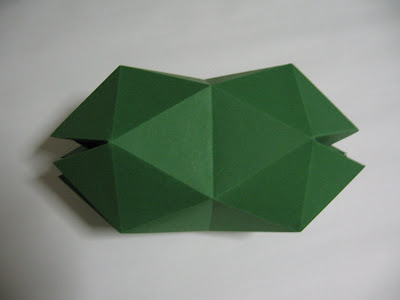I'm posting this to ensure that this blog does not become worse than a monthly newsletter... :)
Almost two months ago, I went overseas to Qingdao in Shandong, China for this educational trip in one of Qingdao's top secondary schools. I was supposed to observe classes in Qingdao No.39 Middle School, and I was grouped with a student from the above school to act as a guide. After a few days, when I had to leave, I wanted to give a farewell present to him. I did not want to buy a gift for him (It might seem insincere) so I decided to fold him an origami model.
I learned that he was very interested in and talented in Mathematics, so I decided to fold him a geometrical figure, the more complicated the better. The one I thought appropriate was a regular Icosahedron, so I had to create one as fast as possible.
I managed one without much difficulty (heheh):
Not bad!
I made this model from the leftovers from the paper used to make the House shown in the exhibition at Clementi.
If you see the following diagrams, you will see that the model is mainly a tube with two closed ends. Take note that I've decided to go step by step in showing the folding method, so each of the following diagrams will be accompanied by a short explanation.
This CP lies on a 60-degree grid.
The grey area is a portion of the paper that overlaps, sealing up the gap in the "tube" formed by wrapping the paper around. Note that all the creases in the grey area are identical to those on the extreme left. The grey area can be extended or even shortened, but bear in mind the difficulties that may occur.
After finishing the above CP, the model will look something like this:
This figure has 30 sides, which is cool, but not so much as the Icosahedron.
You'll realise that the ends (far left and far right in the photo) of the figure are not very effeciently closed (in fact, the model I gave to my "buddy" had this problem and it needed two fingers to hold the ends shut, the sealing method came recently), and they open up by themselves easily. Later on in the explanation I'll be showing how to seal up the ends completely.
Now open the model up and fold the following CP:
Brace youself for the twist!
Do take note that the long horizontal crease in the middle has changed from black to red.
By doing the twist, you eliminate the 10 extra sides by compressing them into a "cap" structure, also giving the model its proper shape. The twist also serves to lock the overlapping areas together. This is the hardest step in the model, the rest is all easy!
The flaps that protrude inwards do not lie flat; According to the CP, you will have to bend them slightly upwards.
Now, the model will look like this:
As you can see, the shape of the Icosahedron is coming out.
Now for a zoom-in on the "cap":
The ends of the model here seem to be pretty well sealed, don't they? That's one of the functions of the cap; it bends upwards and flattens the paper in between the ends, making them inseparable.
With a heavy heart, unfold the model again and fold the following CP:
The horizontal crease has changed back to black.
The main step here is to lock the flaps in the lower end shut. Important: The locking of the overlapped areas happen as if there was only 1 layer.
This is what the locking of 1 flap will look like:
And this is what the lower end looks like from the inside after the locking of all 5 flaps (the overlapping area is counted as 1 flap).
The upper-right corner of the photo shows the overlapping area of the model.
You do not have to unfold the model again.
The last step is to do the twist and close the end of the tube. The flaps from the upper ends are carefully slotted in so they are locked by the upward-bending flaps of the twist.
All that's left now is to fold the upper half of the CP. The horizontal crease has turned back to red.
The end result:
An Icosahedron with neatly-closed ends!
This is the third creation of mine involving a 60-degreee grid, I'll be posting one of them sometime soon.
Oh, and keep an eye out for my Chinese New Year Post, it's gonna be great!
Origami as Pure as Snow
shonen
In this blog inspired by Wolf, I showcase models that I design and post information of interest to the origami folder. I also have a photostream in Flickr (the link is down there). Do enjoy your visit here and don't forget to tag or leave a few comments on my work! If you have folded any of my models, please send their pictures to me, and I will be delighted to publish them in this blog. By the way, please check out the "Important Links" below the archives; they are that important :) The "Origami Singapore" page has links to other folders from Singapore. Have fun!
Thursday, January 31, 2008
A Die with 20 Faces?
Subscribe to:
Posts (Atom)
